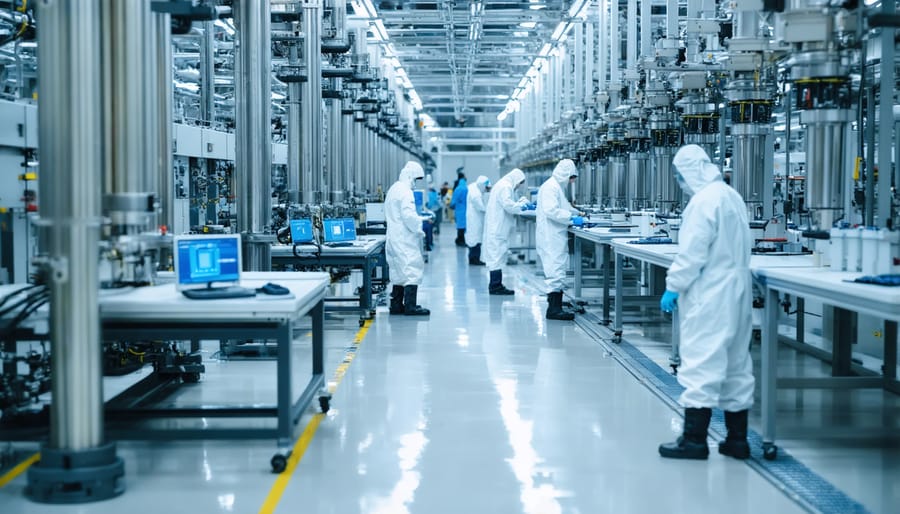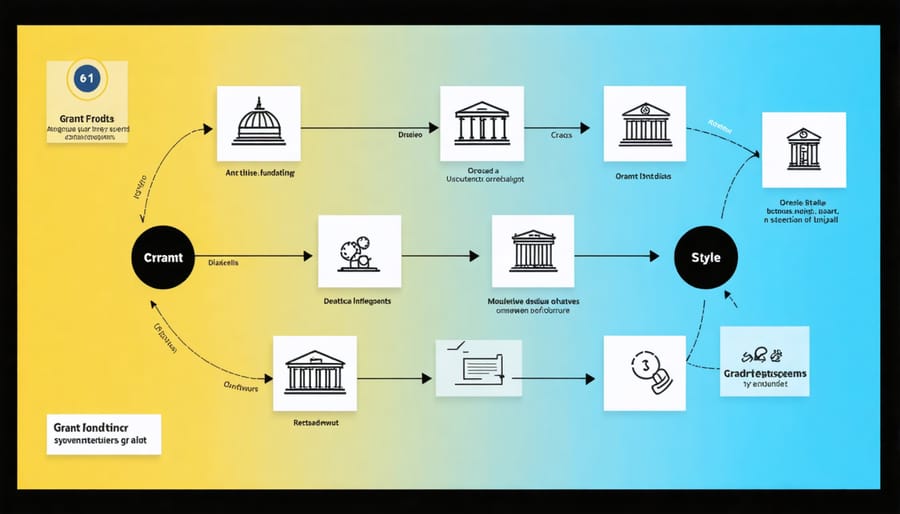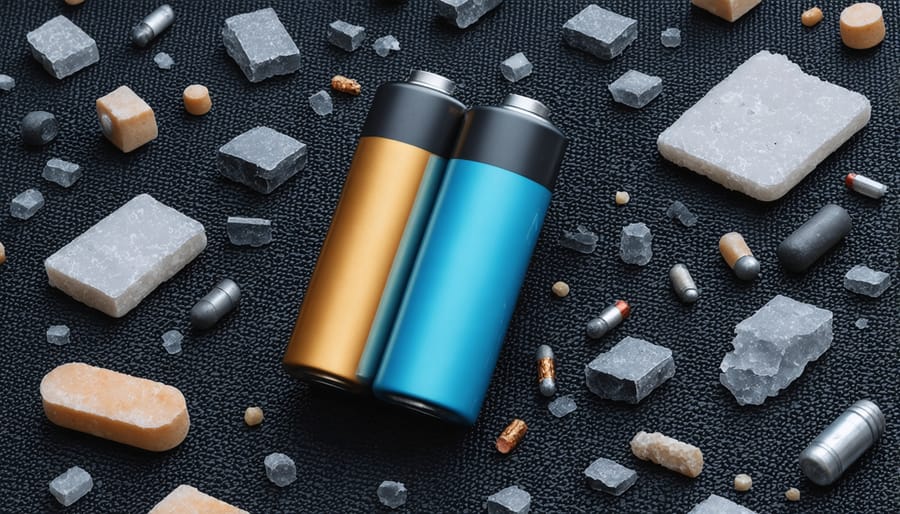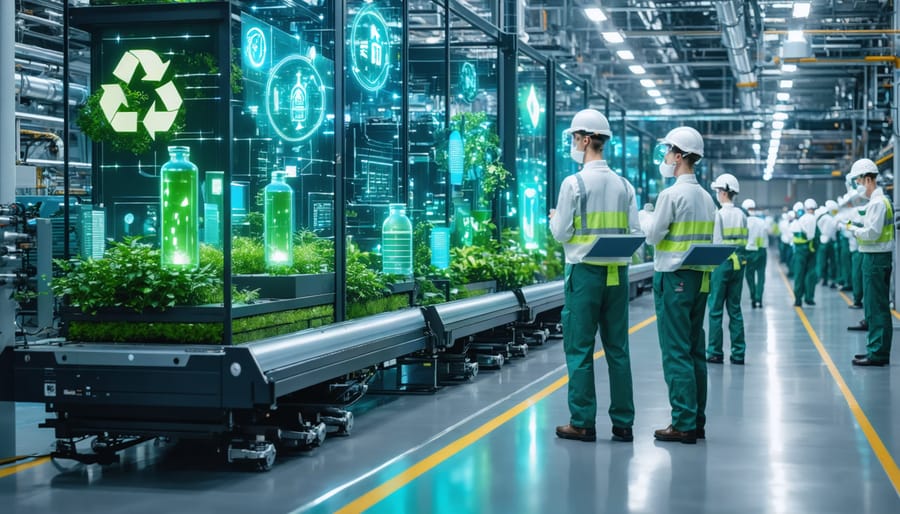Australia’s battery manufacturing and recycling sector stands at the forefront of our clean energy revolution, with unprecedented funding opportunities transforming the landscape. Federal and state governments have committed over $1.5 billion in grants to accelerate domestic battery production and establish world-class recycling facilities. These initiatives target both established manufacturers seeking expansion and innovative startups developing sustainable battery technologies.
The surge in electric vehicle adoption and renewable energy storage demands has created a critical moment for Australian businesses to capitalize on available funding. From the Modern Manufacturing Initiative’s transformation stream to state-specific programs like Western Australia’s Future Battery Industry Strategy, these grants offer comprehensive support across the entire battery value chain.
Success stories like Energy Renaissance’s $525,000 grant for its Hunter Valley manufacturing facility demonstrate the transformative impact of these funding programs. By combining manufacturing excellence with cutting-edge recycling technologies, Australia is positioning itself as a global leader in sustainable battery solutions, creating thousands of green jobs while addressing critical environmental challenges.

Current Battery Manufacturing Landscape in Australia
Key Manufacturing Challenges
While Australia’s battery manufacturing capabilities show tremendous promise, several key challenges need addressing for the industry to reach its full potential. Access to raw materials remains a significant hurdle, despite Australia’s rich mineral resources. The complex supply chains and processing requirements for critical materials like lithium, nickel, and cobalt create bottlenecks in production.
Skilled workforce shortage is another pressing concern, with manufacturers struggling to find technicians and engineers experienced in advanced battery technology. The rapid evolution of battery technology also means continuous investment in training and equipment upgrades is necessary to stay competitive.
Scale and competition pose additional challenges, particularly from established Asian manufacturers who benefit from economies of scale. Australian manufacturers must navigate higher operating costs while maintaining competitive pricing.
However, these challenges are driving innovation in manufacturing processes and spurring development of more efficient recycling solutions. Industry leaders are actively working with education providers to develop specialized training programs and investing in automated manufacturing systems to boost productivity.
Economic and Environmental Benefits
The investment in battery manufacturing and recycling initiatives delivers a powerful double dividend for Australia’s future. By supporting these projects, we’re creating thousands of skilled jobs across the supply chain, from mining and processing to manufacturing and recycling operations. Regional communities particularly benefit, with new facilities bringing employment opportunities and economic diversification to areas traditionally dependent on single industries.
On the environmental front, local battery production significantly reduces the carbon footprint associated with importing batteries from overseas. Moreover, establishing robust recycling facilities helps recover valuable materials like lithium, cobalt, and nickel, reducing the need for new mining operations and preventing hazardous materials from entering landfills. A single recycling facility can process thousands of tonnes of batteries annually, recovering up to 95% of battery materials for reuse.
These initiatives also strengthen Australia’s position in the global green economy, creating export opportunities while supporting our transition to renewable energy. The circular economy approach not only minimizes waste but also ensures a more sustainable and resilient future for coming generations, making every dollar invested work twice as hard for our economy and environment.
Available Grant Programs

Federal Government Initiatives
The Australian Federal Government has significantly ramped up its support for battery manufacturing and recycling initiatives through several comprehensive grant programs. The Modern Manufacturing Initiative (MMI) stands at the forefront, offering matched funding of up to $20 million for projects that expand domestic battery production capabilities and integrate smart storage systems into the national grid.
A cornerstone of these initiatives is the Battery Manufacturing and Recycling Fund, which has allocated $250 million over four years to support innovative projects across the battery value chain. This program specifically targets businesses developing sustainable manufacturing processes and establishing recycling facilities that can process both lithium-ion and traditional lead-acid batteries.
The Cooperative Research Centres Projects (CRC-P) grants provide additional support, offering up to $3 million for industry-led collaborations between researchers and businesses. These grants have already catalyzed several breakthrough projects, including a pioneering battery recycling facility in Western Sydney that recovers 95% of battery materials.
Complementing these programs, the Clean Energy Finance Corporation offers concessional loans to qualifying projects, while the Australian Renewable Energy Agency (ARENA) provides targeted funding for projects that demonstrate commercial viability and environmental benefits. These initiatives collectively form a robust support framework, helping Australia position itself as a leader in sustainable battery technology and recycling solutions.
State-Specific Opportunities
Each Australian state offers unique opportunities for battery manufacturing and recycling initiatives, reflecting local priorities and resources. Victoria leads the charge with its $20 million Battery Manufacturing and Recycling Fund, supporting businesses transitioning to sustainable battery production. The program specifically targets regional areas, offering matched funding of up to $2 million per project.
New South Wales provides substantial support through its Net Zero Industry and Innovation Program, with dedicated funding streams for battery manufacturing facilities and recycling infrastructure. Grants range from $100,000 to $5 million, with particular emphasis on projects demonstrating innovative recycling technologies.
Queensland’s Resource Recovery Industry Development Program focuses heavily on battery recycling, offering grants up to $1 million for establishing new facilities or upgrading existing ones. The state’s emphasis on creating regional jobs makes these grants especially attractive for businesses in rural areas.
Western Australia, with its rich mineral resources, provides targeted support through the Future Battery Industry Strategy. Grants of up to $2 million are available for projects that strengthen the local battery value chain, from mining to recycling.
South Australia’s Green Industries SA offers specific funding for battery recycling initiatives, with grants up to $500,000 available for innovative projects. The state’s commitment to renewable energy makes these opportunities particularly valuable for businesses looking to establish recycling operations.
Tasmania and the Northern Territory offer smaller but focused grant programs, typically ranging from $50,000 to $250,000, with emphasis on regional development and environmental protection.
Industry Partnership Grants
The Australian government actively promotes collaboration between private enterprises and public institutions through targeted industry partnership grants. These initiatives create powerful synergies that accelerate innovation in battery manufacturing and recycling technologies.
Leading manufacturers can access matched funding of up to $5 million through the Industry Growth Centre Initiative, which specifically supports projects focusing on sustainable battery production and end-of-life solutions. These partnerships have already yielded impressive results, with companies like Battery Minerals Australia successfully establishing state-of-the-art recycling facilities through public-private collaboration.
The Modern Manufacturing Initiative offers substantial co-investment opportunities, particularly for projects that demonstrate strong potential for scaling up and creating jobs in regional areas. Successful applicants typically contribute 50% of project costs, with the government matching the investment to drive innovation and sustainability in the battery sector.
To strengthen these partnerships, the government also provides additional support through research institution connections, helping businesses access cutting-edge expertise and facilities. The CSIRO’s Battery Innovation Hub exemplifies this approach, offering industry partners access to world-class research capabilities and testing facilities.
For businesses considering partnership grants, it’s essential to demonstrate clear commercial viability, environmental benefits, and potential for industry-wide impact. Regular grant rounds open throughout the year, with applications typically requiring detailed business cases and implementation strategies.
Battery Recycling Innovation
Emerging Recycling Technologies
The landscape of battery recycling technologies is rapidly evolving, with innovative solutions emerging across Australia. Direct recycling methods are gaining traction, allowing for the recovery of battery materials without extensive chemical processing. This approach preserves the crystal structure of cathode materials, significantly reducing energy consumption and processing costs.
Hydrometallurgical recycling has shown remarkable promise, using water-based solutions to extract valuable metals from spent batteries. This method boasts recovery rates of up to 95% for critical materials like lithium, cobalt, and nickel, while maintaining a smaller environmental footprint compared to traditional techniques.
Australian researchers have developed groundbreaking mechanical separation processes that can sort battery components with unprecedented precision. These systems use automated sorting technology and artificial intelligence to identify different battery chemistries, streamlining the recycling process and improving resource recovery rates.
Biological recycling methods are also emerging as an eco-friendly alternative. Specially cultivated bacteria can extract metals from battery waste through a process called bioleaching, offering a natural and low-energy solution to battery recycling challenges.
Perhaps most exciting is the development of closed-loop systems, where manufacturers design batteries with recycling in mind. These “circular economy” approaches incorporate easily separable components and standardised materials, making end-of-life processing more efficient and cost-effective.
These technological advances are transforming battery recycling from a necessary environmental service into a profitable industry sector, creating new opportunities for Australian businesses while supporting our transition to renewable energy storage solutions.

Success Stories
In Western Sydney, Renewable Batteries Australia (RBA) showcases what’s possible with grant support. After receiving a $3.5 million manufacturing grant in 2021, RBA transformed their small operation into a state-of-the-art facility that now processes over 3,000 tonnes of batteries annually. Their success not only created 45 new jobs but also established a circular economy model that other businesses are eager to replicate.
Another inspiring example comes from Adelaide, where GreenCycle Solutions leveraged a $2.8 million recycling grant to develop innovative battery recycling technology. Their process now recovers 95% of materials from end-of-life batteries, setting new benchmarks for the industry. The company’s achievement caught international attention, leading to technology export opportunities across the Asia-Pacific region.
The regional success story of Battery Second Life in Bendigo demonstrates how smaller enterprises can make a significant impact. With a modest $800,000 grant, this family-owned business pioneered a specialized recycling program for electric vehicle batteries. They’ve since partnered with major automotive manufacturers and created a sustainable model for regional battery recycling.
Perhaps most impressive is the collaboration between Indigenous-owned Sustainable Power Solutions and the CSIRO in Northern Territory. Their joint venture, supported by a $4.2 million grant, combines traditional environmental stewardship with cutting-edge recycling technology. The project not only processes batteries but also provides training and employment opportunities for local Indigenous communities.
These success stories demonstrate how targeted grant funding can drive innovation, create jobs, and advance Australia’s position in the global battery recycling industry.
How to Apply for Battery Grants
Application Requirements
To be eligible for battery manufacturing and recycling grants, applicants must be registered Australian businesses or organizations with a clear focus on sustainable battery solutions. Primary requirements include a detailed business plan demonstrating financial viability, environmental impact assessments, and proof of technical capability in battery manufacturing or recycling processes.
Essential documentation includes current financial statements, environmental compliance certificates, and a comprehensive project timeline. Applicants must also provide evidence of matching funds, typically 50% of the total project cost, though this may vary by program. A thorough risk management strategy and safety protocols are mandatory.
Organizations need to demonstrate their commitment to creating local jobs and supporting the circular economy. This includes detailed workforce planning and training programs. First-time applicants are encouraged to submit an expression of interest before proceeding with a full application.
Additional requirements include letters of support from industry partners, local council approvals where applicable, and evidence of previous experience in similar projects. All applications must outline clear, measurable outcomes and include a robust monitoring and evaluation framework.
Tips for Success
To strengthen your grant application, start by clearly demonstrating your project’s environmental impact and economic viability. Focus on highlighting specific outcomes, such as projected recycling volumes or manufacturing capacity improvements. Include detailed metrics and realistic timelines that show you’ve done your homework.
Build strong partnerships with research institutions or industry leaders to add credibility to your proposal. These collaborations often strengthen your application and demonstrate broader industry support. Remember to emphasise how your project aligns with Australia’s battery recycling goals and circular economy initiatives.
Documentation is crucial – provide comprehensive business plans, feasibility studies, and environmental impact assessments. Be specific about your technology choices and explain why they’re the most suitable for your project.
Don’t forget to showcase your team’s expertise and track record. Include examples of past successes and explain how these experiences will contribute to your project’s success. Address potential risks head-on and outline clear mitigation strategies.
Keep your application concise but thorough. Use clear, straightforward language and avoid technical jargon unless necessary. Finally, submit well before the deadline to allow time for any required revisions or additional documentation requests.
Battery manufacturing and recycling grants represent a crucial stepping stone towards Australia’s sustainable future. These financial initiatives are already transforming our renewable energy landscape, creating jobs, and establishing a robust circular economy for battery materials. As we look ahead, the continued investment in these programs promises to position Australia as a global leader in battery technology and recycling innovation. The growing commitment from both government and private sectors suggests an bright outlook, with more funding opportunities expected to emerge. By supporting these initiatives today, we’re not just building a more sustainable battery industry – we’re investing in cleaner energy solutions, reducing waste, and creating lasting positive impact for generations to come. The success stories we’re seeing now are just the beginning of Australia’s journey toward a more sustainable and self-sufficient battery ecosystem.

